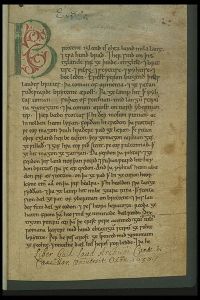A quick news article post today. This story has been making the rounds online, and is relevant to my earlier discussion of interdisciplinarity. Jonathon Allen, a biochemistry student with an interdisciplinary interest in history, hearing about tree ring evidence for a spike in carbon-14 levels in Japanese cedar trees, which is usually caused by a supernova or solar flares, in the year AD 774, has made the connection with a mention in the Anglo-Saxon Chronicle of a strange red crucifix in the sky:
Her Norðhymbra fordrifon heora cyning Alchred of Eoforwic on Eastertid & genamon Æþelred Molles sunu him to hlaforde, se ricsade IIII winter; & men gesegon read Cristes mel on heofenum æfter sunnan setlgange. (ChronD)Her Norðhymbra fordrifon heora cining Alhred of Eoferwic on Eastertid & genamon Æðelred Molles sunu heom to hlaforde, & se rixade IIII gear; & men gesegon read Cristes mel on heofenum æfter sunnan setlangange. (ChronE)
Her Æðelred Molles sunu rixian agann on Norðhymbran, & menn gesegan read Cristes mæl on heouonum æfter sunnan setlegange; on ðan ylcan geare fuhton Myrce & Centwaræ at Ottefordan & wundorlice nædra wæron gesawene on Suðsexan. (ChronF)
"This year the Northumbrians banished their king, Alred, from York at Easter-tide; and chose Ethelred, the son of Mull, for their lord, who reigned four winters. This year also appeared in the heavens a red crucifix, after sunset; the Mercians and the men of Kent fought at Otford; and wonderful serpents were seen in the land of the South-Saxons." (OMACL translation)
He suggests it might have been caused by a supernova partially covered by a dust cloud. This is a nice example of an intersection between history and science. Of course there are many such strange portants recorded in chronicles like these (for instance the odd mention of wonderful snakes in Sussex in the F version of the Chronicle), so it's hard to know what they might mean, but I'd imagine that a medieval or ancient observer is much more reliable than the average modern one. Simply put, they knew their night sky better than we often do, since they had no electric lights. And it's a nice example of a clever insight through interdisciplinary knowledge.

